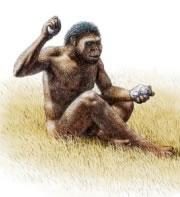 Paranthropus robustus was perhaps smart enough to dig for food.MAURICIO ANTON/ SCIENCE PHOTO LIBRARY
Paranthropus robustus was perhaps smart enough to dig for food.MAURICIO ANTON/ SCIENCE PHOTO LIBRARYPalaeontologists have turned to an unlikely source in a bid to uncover the dietary habits of some of humanity's oldest ancestors. They have studied the teeth of mole rats found in South Africa to bolster the theory that prehistoric hominins may have eaten underground bulbs and tubers, rather than meat or grass.
African mole rats, which live underground and eat starchy plant organs such as bulbs, have similar chemical signatures in their teeth to those of two ancient hominin species found at the same site, the new research shows. This suggests that they may have had similar diets.
The discovery helps to solve a paradox surrounding the diets of Australopithecus africanus and Paranthropus robustus, which lived in southern Africa around 2.5 million and 1.5 million years ago, respectively. When the chemical signatures of their teeth were recently analysed, the results suggested that these hominins ate grassy plants, or the remains of animals that had eaten such plants. But their flat, wide teeth, while good for crushing hard objects, would have been useless at tearing through these tough foods.
A group led by Justin Yeakel of the University of California, Santa Cruz, reasoned that one solution to this problem would be if hominins chewed on the starchy bulbs and tubers from those same grassy plants, rather than tearing up the upper green portions. That would explain both the chemical signature and the design of their teeth.
"Hominins had teeth like ours, which were designed to eat something really, really hard, like small seeds — not tough grasses or raw meat," says Yeakel's colleague Nathaniel Dominy.
Chew on this
The chemical signature in teeth comes about because different foods have a distinctive mixture of carbon isotopes, which shows up in the teeth of animals that eat those foods. Grassy plants, for example, give a particular isotopic signature.
The researchers looked for this signature in the teeth of present-day mole rats (Cryptomys) and in fossilized mole-rat remains from almost 2 million years ago. As they report in Proceedings of the Royal Society B1, the range of isotopes seen in these species overlaps with that found in A. africanus and P. robustus.
ADVERTISEMENT
"This study certainly adds to the body of evidence that the diet of early hominins included bulbs, corms and possibly tubers," says Dominy. These categories include modern-day foods such as the shallot, taro and yam, respectively.
Although one might expect creatures that live underground to feed primarily on underground plant material, how did early humans develop the habit? "Our early ancestors had the advantage of a relatively large brain to help recognize specific plants and to make simple tools for extracting them from the ground," Dominy says.
Visit our ancestorswent_undergrou.html">newsblog to read and post comments about this story.
